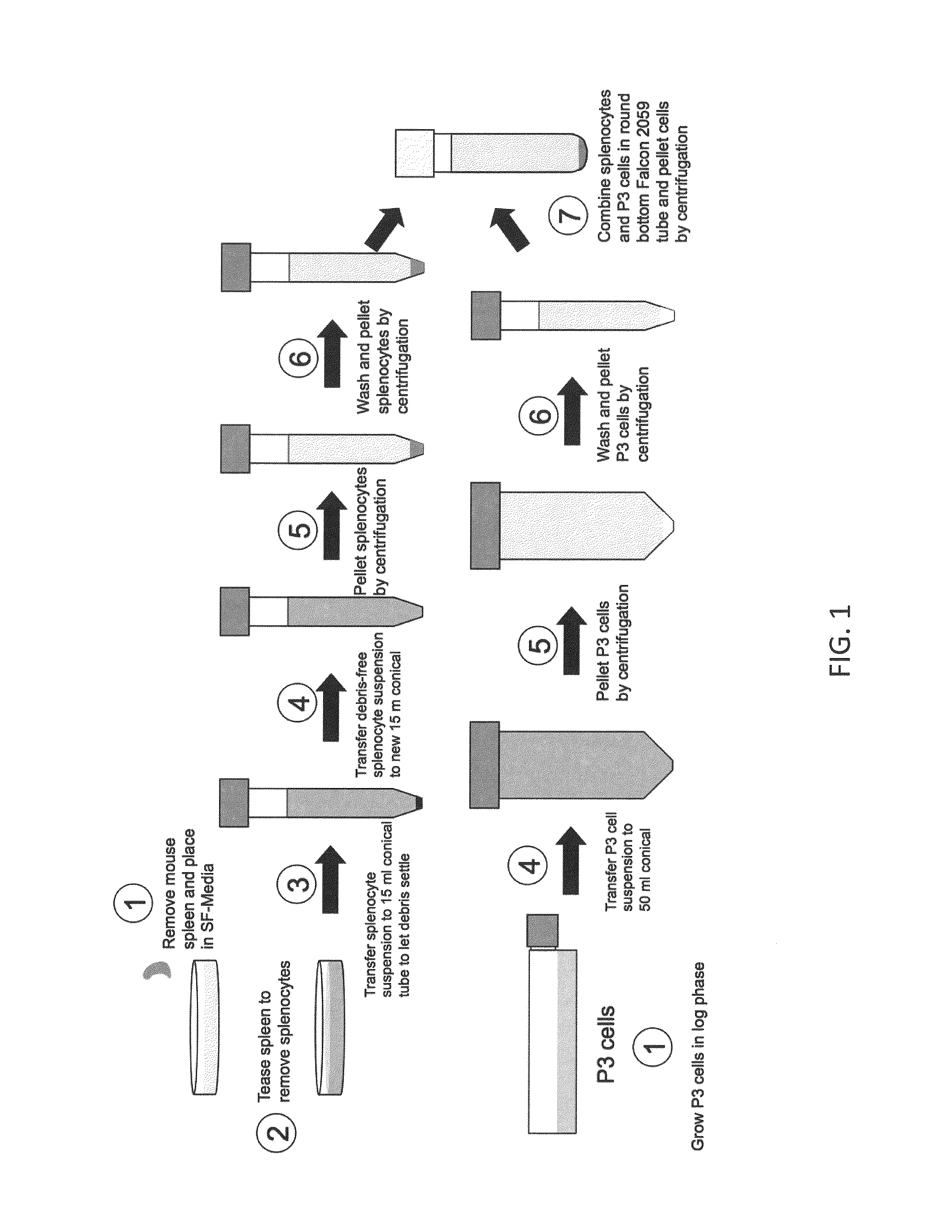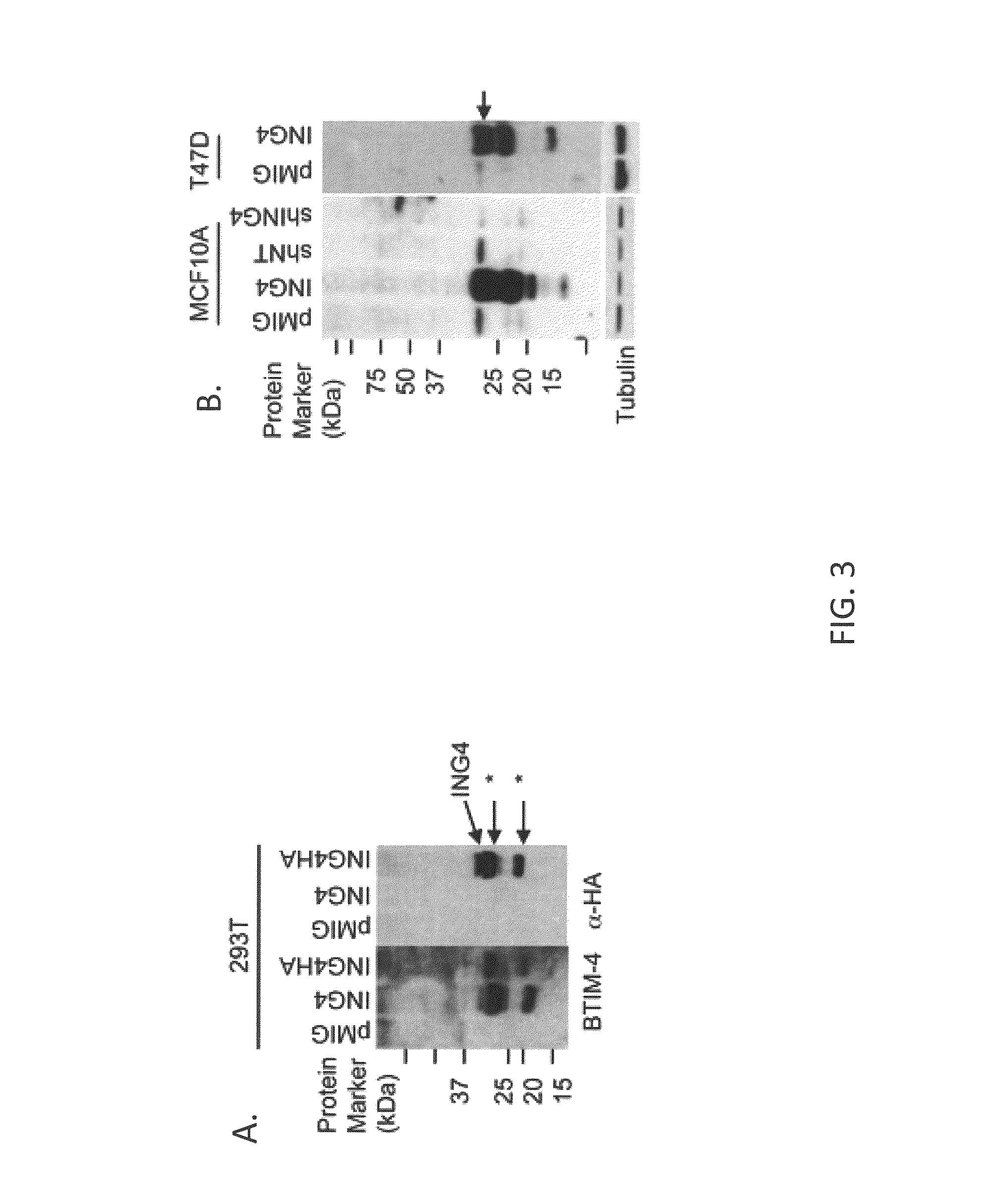Hybridoma clones and monoclonal antibodies to ing4
a technology of hybridoma and monoclonal antibodies, applied in the field of hybridoma clones and monoclonal antibodies, can solve the problems of increased spontaneous tumor formation and insufficient ing4 deficiency alone to initiate tumorigenesis
- Summary
- Abstract
- Description
- Claims
- Application Information
AI Technical Summary
Problems solved by technology
Method used
Image
Examples
example 1
General Hybridoma Production and Screening Protocol
[0114]The following protocols are used for general hybridoma production in the laboratory, as well as for screening and subcloning hybridomas.
[0115]General Hybridoma Fusion Protocol
[0116]Fusion Preparation:
[0117]3-4 days prior to fusion
[0118]1) Two T-75 or one T-225 flask of myeloma cells, P3X653 (P3 cells), at 4×105 cell / ml (30 ml) in 10% HY Medium (or C-DMEM) were set up. Fresh media was added the day before fusion. In addition, during this timeframe, the animals that were used to generate desired lymphocytes for fusion received an intravenous booster injection. Moreover, any equipment that was to be used in harvesting tissue from the animals was autoclaved.
[0119]Day of the Fusion
[0120]On the day of fusion, Fusion Media was prepared as follows: DMEM (LTI) 128 ml, HAT (50×; Sigma) 4 ml, OPI (100×: Sigma) 2 ml, HEPES (1 M; Sigma) 2 ml, Glutamax I (100×; LTI) 2 ml, NCTC (Sigma) 20 ml, FBS (LTI) 40 ml, Pen / Strep (LTI) 2 ml, Nutridoma ...
example 2
Experimental Methods
[0131]Recombinant ING4 Protein Purification for Antibody Generation
[0132]DNA fragments encoding the N-terminal (AA 5-147) (SEQ ID NO:2) or C-terminal (AA 173-249) (SEQ ID NO:3) portion of ING4 were PCR-amplified using the pMIG-ING4 construct (Kim et al. (2004) Proc Natl Acad Sci U S A 101: 16251-16256) as a template with primer pairs: 5-ATGTATTTGGAACATTATCTGGAC (SEQ ID NO:4) and 5′-CCCTTTGGAACGAGCACGAGC (SEQ ID NO:5), 5′-ATGCCCTCAGTGACCTTTGGC (SEQ ID NO:6) and 5′-TTTCTTCTTCCGTTCTTGGGA (SEQ ID NO:7). The DNA fragments were cloned into the pET21b bacterial expression vector (Novagen, Madison, Wis.) in the coding frame with a 6×HIS epitope-tag at the 3′ end of each fragment using EcoRI and Xhol restriction enzymes (New England BioLabs, Ipswich, Mass.). The DNA constructs were used to transform BL21 E. coli (Promega Corporation, Madison, Wis.). Recombinant proteins were induced by adding 1 mM IPTG (Promega) and purified from cell lysate using a Ni-NTA column (Novagen...
example 3
Generation and Screening of Monoclonal ING4 Antibodies
[0148]In order to evaluate ING4 protein expression in breast tumors, a monoclonal antibody was generated that specifically binds to ING4 protein. Mice were immunized with N-terminal (AA 5-147) (SEQ ID NO:2) or C-terminal (AA 173-249) (SEQ ID NO:3) recombinant ING4 protein fragments produced in bacteria and also with Synthetic Peptide corresponding to amino acids 156-178 of ING4 (SEQ ID NO:8) (see FIGS. 2A and 2B). The N-terminal ING4 protein injection generated antibodies that recognized ING4 with specificity, one of which was designated BTIM-4, The BTIM-4 antibody detected full-length ING4 protein and ING4 epitope-tagged with hemagglutinin (HA) at the C-terminal end, which was overexpressed in 293T cells (FIG. 3A). Both BTIM-4 and anti-HA antibodies detected additional ˜26 kDa and 17 kDa species which may represent degradation products of overexpressed ING4 (asterisks in FIG. 3A). BTIM-4 antibody did not cross-react with the oth...
PUM
| Property | Measurement | Unit |
|---|---|---|
| pH | aaaaa | aaaaa |
| pH | aaaaa | aaaaa |
| temperature | aaaaa | aaaaa |
Abstract
Description
Claims
Application Information
 Login to view more
Login to view more - R&D Engineer
- R&D Manager
- IP Professional
- Industry Leading Data Capabilities
- Powerful AI technology
- Patent DNA Extraction
Browse by: Latest US Patents, China's latest patents, Technical Efficacy Thesaurus, Application Domain, Technology Topic.
© 2024 PatSnap. All rights reserved.Legal|Privacy policy|Modern Slavery Act Transparency Statement|Sitemap



